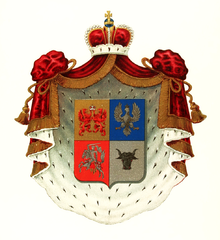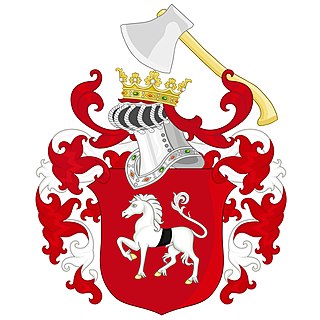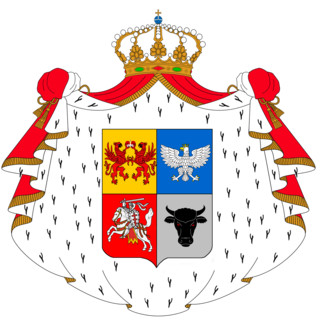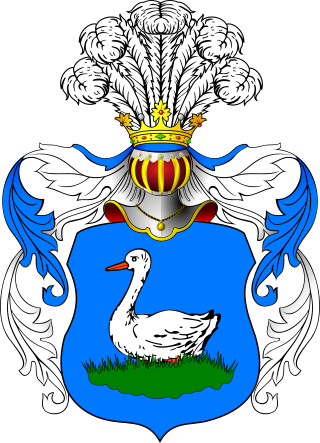| Trubetsky | |
|---|---|
 | |
| Details | |
| Alternative names | Troubetzkoy, Trubecki, Trubic, Трубецкой |
| Earliest mention | 1357 |
| Towns | Trubetsk |
| Families | Trubetsky |
Trubetsky is a Ruthenian-Polish-Russian coat of arms. It has been used by the Trubetsky family.
| Trubetsky | |
|---|---|
 | |
| Details | |
| Alternative names | Troubetzkoy, Trubecki, Trubic, Трубецкой |
| Earliest mention | 1357 |
| Towns | Trubetsk |
| Families | Trubetsky |
Trubetsky is a Ruthenian-Polish-Russian coat of arms. It has been used by the Trubetsky family.
The Trubetsky coat of arms consist of four parts:
| | This section is empty. You can help by adding to it. (July 2010) |
Notable bearers of this coat of arms include:

The coat of arms of Poland is a white, crowned eagle with a golden beak and talons, on a red background.

Ossorya is a Polish coat of arms. It was used by several szlachta families in the times of the Polish–Lithuanian Commonwealth.

Kryszpin is a Polish coat of arms. It was used by several szlachta families in the times of the Polish–Lithuanian Commonwealth.

Mogiła is a Polish coat of arms. It was used by a number of szlachta (noble) families under the Polish–Lithuanian Commonwealth.

Prus I is a Polish coat of arms. It was used by a number of szlachta (noble) families under the Polish–Lithuanian Commonwealth.

Groty is a Polish coat of arms. It was used by several szlachta (noble) families under the Polish–Lithuanian Commonwealth.

Hełm is a Polish coat of arms. It was used by a number of szlachta (noble) families under the Polish–Lithuanian Commonwealth.

Starykoń is a Polish coat of arms. It was used by several szlachta (noble) families under the Polish–Lithuanian Commonwealth. Notable bearers of this coat of arms include Jan Wielopolski.

The House of Trubetskoy, is a Russian gentry family of Ruthenian stock and Lithuanian origin, like many other princely houses of Grand Duchy of Lithuania, later prominent in Russian history, science, and arts. They are descended from Algirdas's son Demetrius I Starshy. They used the Pogoń Litewska coat of arms and the Trubetsky coat of arms.

Gąska is a Polish coat of arms. It was used by several szlachta families in the times of the Polish–Lithuanian Commonwealth.

Napiwon is a Polish coat of arms. It was used by several szlachta families in the times of the Polish–Lithuanian Commonwealth.

Przerowa is a Polish coat of arms. It was used by several szlachta families in the times of the Polish–Lithuanian Commonwealth.

Rosyniec is a Polish Coat of Arms. It was used by several szlachta families in the times of the Polish–Lithuanian Commonwealth.

Krukowski is a Polish coat of arms. It was used by one szlachta family in the times of the Polish–Lithuanian Commonwealth.

Kurowski is a Polish coat of arms. It was used by several szlachta families in the times of the Polish–Lithuanian Commonwealth.

Wysocki is a Polish coat of arms. It was used by several szlachta families in the times of the Polish–Lithuanian Commonwealth.

Sas II is a Polish coat of arms. It was used by several szlachta families in the times of the Polish–Lithuanian Commonwealth.

Kur II is a Polish coat of arms. It was used by several szlachta families in the times of the Polish–Lithuanian Commonwealth.

Wigund-Jeronym Trubecki or Yuri Nikitich Trubetsky as he was called earlier in Muscovy was the Prince of Trubetsk from 1611 to 1634, preceded by Symeon Iwanowicz Perski Trubecki, succeeded by Piotr Trubecki, and Aleksander Trubecki. Yuri Nikitich Trubetsky was also a boyar and equestrian of False Dmitry II. After emigrating to Poland, and restoring The Principality of Trubetsk, he converted to Catholicism, and took the name Wigund-Jeronym Trubecki.